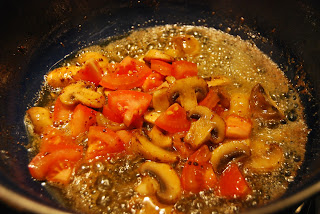In earlier times, more than half of the Dutch population would be eating this meal on Sunday. When talking about predictability, the Dutch are such an easy read -- nasi goreng (Indonesian fried rice) on Wednesdays, boerenkool stampot (mashed potato with farmer's cabbage) when the first frost hits the ground, or barbeques on the predicted warm days in summer.
Over the years as life became more prosperous, as more people are able to go abroad for holidays, new eating patterns and habits have come to evolve. Fast foods, pizza houses, Chinese take-aways have cornered a sizeable portion of the population who now prefer to just sit in front of the televisions instead of slaving in the kitchen.
Hubby is still very much conservative and the typical Sunday meals he had growing up are his preferred comfy foods on Sundays. I actually don't mind and has actually learned to appreciate these meals the way he does.
Let me share you one of these comfy meals…chicken with gravy, boiled potatoes and cauliflower in creamy cheese sauce. I used cauliflower for veggie because it is in season.
Ingredients:
2 chicken legs
1 whole cauliflower
Butter
Salt
Pepper
100g Grated cheese
5 tbsps Corn starch
200ml Milk
Optional:
Mushrooms, sliced
Tomatoes, chopped  |
| Season the chicken with salt and pepper |
In a saucepan, add about 60g of butter. You don't need a lot of butter to cook the chicken as opposed to the usual way of deep frying chicken.
When the butter has turned slightly brown, place chicken and reduced the heat/fire to medium. Keep the lid on so that the chicken will cook in its own steam/moisture.
 |
| Turn when the other side has turned brown. You can also turn the heat to low to ensure that the chicken does not burn before the innermost part is cooked. |
 Once the chicken is cooked, remove from the pan to be able to make the gravy from the butter used in frying.
Once the chicken is cooked, remove from the pan to be able to make the gravy from the butter used in frying.To make the gravy, add a little bit more butter and then add the mushrooms.

Fry for a minute or two then add the tomatoes. Add a small amount of water. Check the taste if still not salty enough.
You can add a bit more salt or Maggi seasoning and some ground pepper. Let it boil and the the gravy has thickened, turn off the heat/fire.
Boiled Potatoes:
Peel the potatoes, place it in a pan filled with water to just about 2/3 of the level of the potatoes.
Boil for about 20 minutes or until the potatoes are cooked.
Cauliflower in creamy cheese sauce:
- In a deep saucepan, boil the cauliflower. Water should cover the entire cauliflower. Add some salt as well.
- Boil for about 20 minutes (could be less) but turn the other way around halfway into the cooking period.
- Once cooked, remove from the pan.
- To make the creamy cheese sauce, you will need to heat up in a saucepan about 150ml milk. Also mix about 5 tbsps corn starch with 50ml cold milk and when thoroughly mixed, add to the warm milk. Add the grated cheese. Continue stirring and when the cheese has melted, the sauce is done. Pour the cheese sauce on top of the cauliflower and top that with grated nutmeg.

As we say in Dutch, "eet smakkelijk"!





































